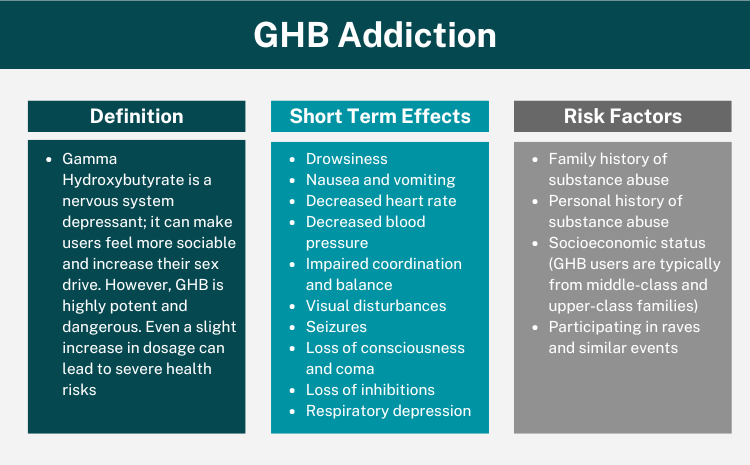Understanding GHB Addiction: Signs and Its Effects
GHB, a synthetic drug developed in the 1920s, is known for its euphoric and sedative effects. Originally created as an anesthetic, it’s now often misused for its ability to produce intense feelings of relaxation and happiness. Unfortunately, its potent sedative properties have also made it a date rape drug.
This guide will delve into what GHB is, its effects, and how to recognize the signs of addiction. By getting a clear picture, we can better support those struggling and address the wider issue.

What Is Gamma Hydroxybutyrate (GHB)?
Gamma Hydroxybutyrate is a nervous system depressant; it can make users feel more sociable and increase their sex drive. However, GHB is highly potent and dangerous. Even a slight increase in dosage can lead to severe health risks, including unconsciousness, respiratory problems, and potentially death.
GHB’s effects can be unpredictable, making it particularly risky. Dependence on this drug can develop quickly, leading to both physical and psychological addiction. Understanding the nature of GHB and the dangers it poses is essential for recognizing the signs of abuse and seeking appropriate help.
Street Names for GHB
GHB goes by many street names, which can sometimes make it hard to identify. You might hear it called G, Gina, Liquid Ecstasy, Liquid X, or Liquid G. Other names include Goop, Georgia Home Boy, Grievous Bodily Harm, and Easy Lay. Knowing these terms can help you recognize when GHB is being discussed, making it easier to identify potential abuse early on.
Appearance and Forms
GHB is typically produced illegally in clandestine labs, both locally and abroad, and is often sold at bars or rave parties in its liquid form. In its liquid form, GHB can be easily mixed into drinks, making it particularly dangerous as it can be ingested without the user’s knowledge. Besides the liquid form, GHB also exists as a white powder or in crystals, though this is less common.
The Mechanism and Effects of GHB
At low doses, GHB can make users feel more sociable, less inhibited, and lightheaded, similar to the effects of alcohol. Slightly higher doses can intensify these effects or cause drowsiness and dizziness. Further increases may lead to nausea, vomiting, and a deep sleep. An overdose of GHB can cause severe complications such as difficulty breathing, lowered heart rate, convulsions, and even death.
It is important to note that the difference between a dose that produces the desired effects and one that is dangerous is very small. A slight excess can have fatal consequences. Additionally, GHB can cause confusion, unusual and disturbing thoughts, and depression, highlighting the drug’s significant risks.
How GHB affects you can vary based on several factors:
- Your age and body weight
- How much you take and how often you take it
- How long you’ve been using it
- The method you use to take the drug
- The environment you’re in
- Whether you have certain pre-existing medical or psychiatric conditions
- Whether you’ve taken any alcohol or other drugs
How GHB Works in the Body
GHB is classified as a central nervous system depressant. It primarily affects the brain by interacting with GABA receptors, specifically the GABA-B type. GABA, or gamma-aminobutyric acid, is a neurotransmitter that inhibits or slows down brain activity. When GHB binds to these receptors, it increases the inhibitory effects, leading to feelings of relaxation, drowsiness, and sedation.
Unlike other depressants like alcohol or benzodiazepines, which work on the GABA-A receptors, GHB’s unique interaction with GABA-B receptors results in different effects and risks. This distinction is crucial because it explains why even a small increase in GHB dosage can have severe and sometimes fatal consequences.
Short Term Effects of GHB
The short-term effects of GHB can occur quickly, sometimes within minutes of taking the drug. These effects vary in severity and can be dangerous.
Common short-term effects include:
- Drowsiness
- Nausea and vomiting
- Decreased heart rate
- Decreased blood pressure
- Impaired coordination and balance
- Visual disturbances
- Seizures
- Loss of consciousness and coma
- Loss of inhibitions
- Respiratory depression
These side effects can be more severe when GHB is combined with other substances, like alcohol, or taken in high doses. If you or someone else experiences these effects after using GHB, it is crucial to seek medical help immediately.
Long Term Effects of GHB
The long-term effects of GHB abuse can be really serious. The biggest risk is developing physical dependence or addiction. As users develop a tolerance, they need to take increasing amounts to achieve the same effects, leading to a higher risk of dangerous overdoses.
If someone who has been using GHB for a long time suddenly stops, they will experience withdrawal symptoms. These symptoms can be very uncomfortable and sometimes life-threatening. Long-term GHB abuse can also cause significant sleep problems, such as difficulty falling asleep and disturbed sleep patterns.
These long-term side effects highlight the critical need to avoid GHB abuse and seek help if addiction occurs.
Signs and Symptoms of GHB Addiction
Recognizing the signs and symptoms of GHB addiction is crucial for early intervention and support. The effects of GHB can begin within 20 minutes of ingestion and last for several hours. Here are some common indicators of GHB abuse:
Behavioral Symptoms:
- Clumsiness
- Slurred speech
Physical Symptoms:
- Lowered body temperature
- Slowed heart rate
- Depressed respiration
- Nausea, vomiting, and diarrhea
- Loss of muscle control
- Tremors
- Excessive perspiration
- Heightened sexual arousal
Cognitive Symptoms:
- Increased sensitivity to light and sound
- Confusion and disorientation
- Memory problems, including blackouts and amnesia
Psychosocial Symptoms:
- Lowering of inhibitions
- Profound relaxation
- Decreased sense of anxiety
- Feelings of euphoria
These symptoms can vary in intensity and may be more severe when GHB is taken in high doses or combined with other substances. If you notice these signs in yourself or someone else, it is important to seek medical help immediately. Early recognition of these symptoms can lead to more effective treatment and a better chance of recovery.
Causes and Risk Factors for GHB Addiction
The likelihood of abusing or becoming dependent on GHB can be influenced by various environmental and genetic factors. Here are some key factors to consider:
Genetic Factors:
- Family history of addiction: Studies suggest that the children of addicted parents are much more likely to struggle with addiction themselves.
- Genetic predisposition: Research involving twins and adopted children shows a strong genetic component to addiction.
Environmental Factors:
- Childhood environment: Growing up in a household where drug abuse was common can increase the likelihood of GHB abuse.
- Trauma: Individuals who experienced abuse, neglect, or other trauma in childhood are at higher risk.
- Social influences: Attending clubs, raves, and other places where GHB is prevalent can be a strong environmental influence.
- Peer pressure: Associating with peers who use GHB can significantly increase the likelihood of abuse.
Risk Factors:
- Family history of substance abuse and/or mental illness
- Personal history of prior substance abuse and/or mental illness
- Youth (GHB abusers are usually under age 30)
- Socioeconomic status (GHB users are typically from middle-class and upper-class families)
- Participating in raves and similar events
- Attending clubs where GHB is commonly abused
Understanding these risk factors can help in identifying individuals who might be at higher risk for GHB addiction.
The Dangers of GHB Use
GHB Withdrawal
GHB acts on GABA receptors in the brain, similar to benzodiazepines and alcohol. This means its withdrawal symptoms can be just as complicated and potentially lethal. While some people unknowingly consume GHB, others abuse it for recreational purposes or because they believe it has health benefits.
When someone stops taking GHB after regular use, they are likely to experience uncomfortable withdrawal symptoms. It’s crucial to seek a medically supervised detox to manage these symptoms safely. Medical professionals can use a tapering process to control and reduce the risk of severe withdrawal symptoms.
Symptoms of GHB Withdrawal:
- Anxiety
- Insomnia
- Shaking
- Sweating
- Increased heart rate
- Psychotic thoughts
- High blood pressure
- Hallucinations
- Physical tremors
- Delirium
- Extreme confusion
- Changes in mood
- Aggression
GHB withdrawal can be severe and incapacitating. The discomfort and intense cravings often cause people to relapse, continuing the cycle of abuse. This increases the risk of overdose because their tolerance has decreased, making it harder to metabolize high doses.
Withdrawal symptoms can start within a few hours after stopping GHB due to its rapid metabolism. The initial signs include anxiety attacks, rapid pulse, high blood pressure, and sweating. For short-term users, symptoms may improve within a few days. However, those who have been abusing high doses for a longer period may experience withdrawal stages. Mild withdrawal usually lasts three to five days, while severe cases can take up to two weeks.
Risks of Mixing GHB with Alcohol
Mixing GHB with alcohol is very dangerous. Both substances slow down brain activity and bodily functions. When combined, they amplify each other’s effects, leading to serious health risks like respiratory failure, unconsciousness, and even death.
Using GHB and alcohol together also increases the chance of becoming dependent on them. This means the brain starts to rely on these substances to function normally. As a result, people feel the need to continue taking these substances to avoid withdrawal symptoms.
Treatment and Recovery from GHB Addiction
Detoxification and Withdrawal Management
Detoxification from GHB often requires medical supervision. Medical detox facilities typically offer closely monitored, small doses of benzodiazepine drugs, like Valium, to ease initial withdrawal symptoms. This approach can improve mood and physical comfort, reducing the risk of early relapse.
In addition to benzodiazepines, some medical detox specialists use other medications to treat specific withdrawal symptoms. These can include:
- Barbiturates to manage seizures
- Anticonvulsants to control muscle spasms
- Antipsychotic medications to address hallucinations
Managing GHB withdrawal can be complex and sometimes dangerous. Symptoms can resemble those of alcohol and benzodiazepine withdrawal, which may include life-threatening conditions. Therefore, professional medical detox is crucial for safe and effective withdrawal management.
Rehabilitation Programs
Combining medications with behavioral therapy is crucial for effective treatment. Rehabilitation programs for GHB addiction, whether inpatient or outpatient, provide structured support to help individuals achieve and maintain sobriety. These programs typically include a combination of individual therapy, group counseling, and educational sessions, all aimed at changing thoughts and behaviors related to drug use. This comprehensive approach reduces the risk of relapse, overdose, and subsequent addiction, offering a well-rounded path to long-term recovery.
Seeking Help
If you or someone you know is struggling with GHB addiction, seeking help is crucial. Early intervention can prevent severe health complications and support recovery. Medical detox, combined with behavioral therapy and rehabilitation programs, offers the best chance for long-term sobriety. Don’t wait—reach out to a professional treatment facility today to start the journey towards a healthier, drug-free life.
